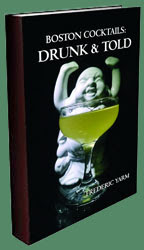 I began Friday morning at Tales of the Cocktail with a talk on beer flaws that was moderated by Elayne Duff (Global Manager of Training at InBev, prev. Diageo head mixologist) along with presenters Mirella Amato (Global Director of Beer Knowledge at InBev, master cicerone, and author of Beerology) and Steve Riley (founder of BetterBeer.com, certified cicerone).
I began Friday morning at Tales of the Cocktail with a talk on beer flaws that was moderated by Elayne Duff (Global Manager of Training at InBev, prev. Diageo head mixologist) along with presenters Mirella Amato (Global Director of Beer Knowledge at InBev, master cicerone, and author of Beerology) and Steve Riley (founder of BetterBeer.com, certified cicerone).The seminar discussed the many reasons why beer goes bad. Beer unlike spirits is a delicate beverage. Even if it was perfectly brewed, mishandling will change its aroma and flavors, and these new notes are called "off flavors." Learning to identify these off flavors are useful in addressing customer complaints (or using them to detect them before they get into the hands of customers). Beer has four major enemies: time, heat, oxygen, and light. In addition, bacteria such as those that break down sugars into lactic acid are an enemy as well.
To demonstrate three flaws, Budweiser was spiked with lab samples of off flavors with a sample of pure Budweiser offered as a control to determine baseline notes. The first off flavor was T2N (trans-2-nonenal) which provided no aroma but came across as a flat taste of wet cardboard, dusty books, and old (or Dollar Store) lipstick. The causes of this flaw are oxygen, and these oxidative flavors are precipitated by both heat and oxygen. For a light lager, these notes can develop in a few months, and more complex beers can mask these notes. Storing beer cold will help to delay this change; always store the beer colder than the temperature at which it was fermented. Moreover, always check the expiration date on beer when it is delivered and practice FIFO (first in, first out) inventory rotation. In unopened beer, this is often a packaging error at the brewery. For keg beer, some bars still use air compressors instead of CO2 of N2 tanks, and this fills the keg with oxygen; while frequent in the past, these units are rare but still in the market. In comparing beer to fortified wines, liqueurs, and spirits, oxygen and heat will cause color changes in St. Germain, give off flavors in gin, and decrease the creaminess of whiskey. However, oxygen is useful in developing flavors like rancio, the nutty flavor in Cognac that appears after a decade or so in barrels, as well as the nutty flavors in some aromatized wines like Spanish vermouth. In fact, there are a few beers that are stored with oxygen to generate madeira and sherry-like notes.
The second off flavor was mercaptan which is known as lightstruck. This flavor is the reaction of hop's bittering compounds and ultraviolet light that quickly occurs in clear and green bottles, slowly in brown bottles, and not at all in cans. This aroma is reminiscent of skunk, cat litter, and sewer gas, and it is generated when ultraviolet light triggers alpha-acids (bittering agents in hops) to break off a free radical that combines with a sulfur compound in beer to make a chemical that is close to that found in a skunk's glands. Miller High Life gets around this problem by using hop extracts that are isomerized to deliver bitterness while being light insensitive. On premise places can get sleeves to go over their fluorescent light bulbs to block out some of the UV. While incandescent and LED lights have little effect, daylight can effect the beer in as little as 5 minutes. Light can also change spirits such as whiskeys losing their color which can effect perception by consumer. The panel could not come up with any positive uses of ultraviolet light exposure.
The third off flavor was diacetyl that comes across like buttered popcorn, smells like the bar the morning after, and offers a slick mouthfeel; the butter and creaminess was compared to a Werther's candy. The issue is generally attributed to dirty beer lines that contain anaerobic bacteria such as lactobacillus and pediococcus. However, diacetyl can also be a byproduct of fermentation that is generated by the yeast themselves. One major difference is that yeast do not add a sour note, while these bacteria do, so buttery + no acid stems from a brewery issue, and buttery + acid stems from the bar's equipment and maintenance. These bacteria can be prevented by being mindful when changing kegs, visually inspecting and cleaning the coupler every keg change, never resting the coupler on the floor, and wiping the faucet with hot water to clean off bacteria. Line cleanings generally take a minimum of an hour to clean 10 lines properly, so if your service is faster than that, it is probably incomplete.
Not all lactic acid bacteria are bad for it can be utilized in the ferment to control the growth of other bacteria and it can create the proper pH for yeast to work such as in sour mash in whiskey. It can also be used in rum such Jamaican ones where the backset in dunder contains lactic acid bacteria to create a more flavorful product. Finally, certain German beer styles such as gose and Berliner weisse utilize these microbes to good effect.
A longer list of flaws and their descriptions can be found here as well as in many beer books.
The final point that was brought up was glassware and how to improve cleanliness. A clean beer glass will have CO2 gas bubbles cascading up to make a head on the beer that lasts, and after each sip, the head will leave lacing on the glass. A dirty glass will have large fisheye bubbles, lose carbonation and head, and will have bubbles stuck to the glass' wall. Some frequent causes are finger print oil from the "spider-carry", dairy (such as when the staff uses that glassware for coffee), sugar resin from soft drinks, and oils from greasy silverware and napkins being jammed in during a table clearing. Three compartment sinks are not efficient at cleaning off oils, and a pub scrub such as KissKlean can be utilized to remove grease. Finally, frozen glassware will create flat tasting beer akin to sticking a beer can in the freezer.
 The 2017 collection of 855 drink recipes, bartender tributes, and essays on hospitality from CocktailVirgin's Frederic Yarm. Available at
The 2017 collection of 855 drink recipes, bartender tributes, and essays on hospitality from CocktailVirgin's Frederic Yarm. Available at  The 2012 collection of 505 drink recipes, techniques, and Boston bar recommendations from Frederic Yarm. Available at
The 2012 collection of 505 drink recipes, techniques, and Boston bar recommendations from Frederic Yarm. Available at 




1 comment:
What an awesome article!! Our team has been maintaining draught lines for over 25 years in Atlantic Canada. Regular Preventative Maintenance is critical to eliminating "off flavours". We here at Draught Pro thank you for bringing more awareness to this important issue with draught line maintenance.
Jeff Harrington
President
Draught Pro
Post a Comment